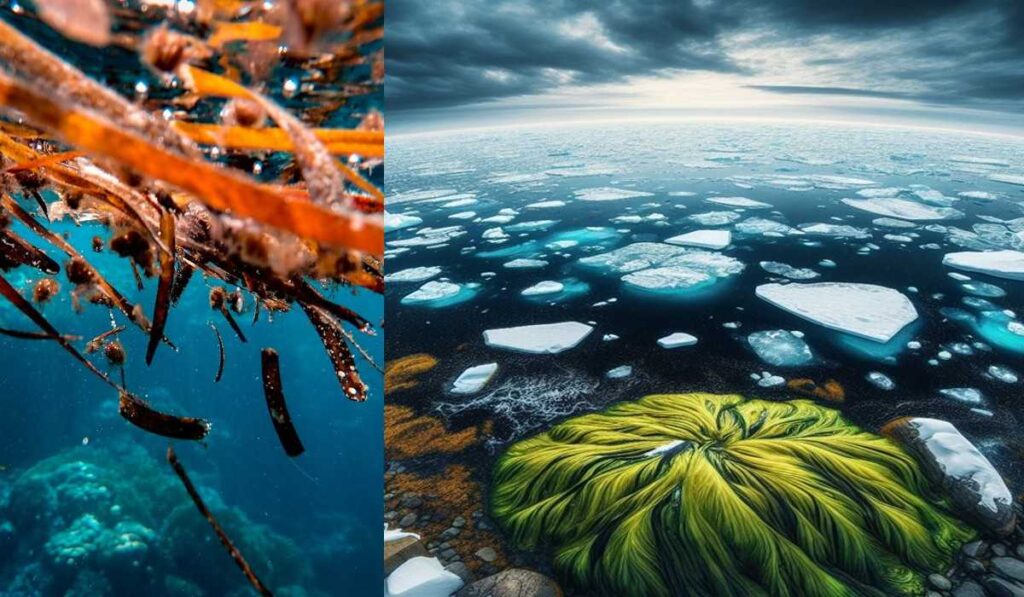Scientists are saying that global warming is affecting the Arctic Ocean differently for various species. While seaweed benefits from more sunlight, other marine life is struggling due to increased exposure. The Arctic ice is melting rapidly, with a significant one million square km reduction over the last 25 years.
This influences the sunlight reaching seafloor ecosystems, with varied effects on different species. The research team from Denmark focused on the shallow areas of the Arctic Ocean, studying how sunlight exposure changed over the years for microalgae, seaweeds, and seagrasses.
The results, published in the journal Proceedings of the National Academy of Sciences(PNAS), showed an increase in the area exposed to sunlight, but the total sunlight reaching the seafloor remained unchanged. The consequences of these changes are uncertain, especially for animals like polar bears that depend on this marine life.
Role of Arctic Sea ice

Sea ice refers to frozen seawater that forms a layer on the surface of the ocean. It is different from icebergs or glaciers, as it develops directly from the freezing of seawater. Sea ice is vital for regulating Earth’s climate. It also serves as a habitat for various Arctic and Antarctic species.
Every September, scientists check the amount of Arctic Sea ice using satellite images when the ice is smallest. Since 1979, when the U.S. government began measuring, the Arctic ice has decreased by over 2 million square kilometers. “It’s a big piece of ice lost,” says MIT research on Arctic oceanography. He further says it is a strong sign of climate change.
Satellites are the best way to monitor Arctic Sea ice because space pictures accurately show the size and changes in the ice cover. In September 2022, satellite data revealed that the ice-covered 4.67 million sq. km of the Arctic Ocean, more than 11 times the size of California.
Climate change due to melting of Arctic Ocean
The melting ice is a big deal because it sets off a climate cycle that makes things even warmer. Ice is light in color, and it sends back over 80 percent of the sunlight that comes its way, pushing away warmth from the Earth’s surface. However, when the ice melts, the sunlight now reaches the darker seawater beneath, and only about 10 percent of it reflects back. While the rest is soaked up by the ocean.
Gianluca Meneghello explains, “If you take away the ice, more light hits the ocean, and the ocean gets warmer. So, it becomes harder to make new ice in the next winter.” The Arctic Ocean is like a factory that produces ice, and this ice helps control temperatures in different parts of the world. Without ice, temperatures will go up, and sea levels will rise.
The consequences of Arctic ice melting extend beyond the immediate region. The Arctic acts as a global air conditioner, influences weather patterns, and regulates temperatures. Changes in the Arctic can disrupt these patterns, affecting weather systems and climate conditions worldwide.
Additionally, the melting of the Arctic contributes to rising sea levels globally. As ice on land and sea melts, it adds more water to the oceans, which can lead to coastal flooding and other challenges for communities around the world.
Seaweed growth effect on Arctic Ecosystem

The excessive growth of seaweed in the Arctic Ocean is becoming a problem. As temperatures in the Arctic region rise due to climate change, it creates conditions that are more favorable for the proliferation of seaweed. Warmer waters and changes in nutrient levels contribute to the expansion of seaweed populations.
This unwanted growth of seaweed can have various consequences. It may disrupt the balance of marine ecosystems, affecting the species that depend on specific conditions in the Arctic environment. Seaweed overgrowth can also impact the availability of sunlight for other marine life and alter the habitats where they live.
Furthermore, the increase in seaweed can influence climate patterns. Seaweed absorbs carbon dioxide from the atmosphere, but when it decomposes, it releases greenhouse gases back into the air. This can contribute to the overall warming of the planet. The unwanted expansion of seaweed in the Arctic Ocean is another sign of the changing conditions in this sensitive ecosystem, highlighting the interconnected nature of climate change and its effects on marine life and global environmental processes.
The Arctic Ecosystem is home to wide range of animals such as fish, seals, whales, polar bear, gull birds and invertebrates. Many species are specially adapted to the cold waters and ice-covered conditions.
The impact on marine life is uncertain due to changes in sunlight. Marine life production is on the rise along the coastlines of Greenland and Canada but decreasing along the coastlines of Russia. Conservation efforts are crucial to preserving the unique biodiversity and ecological balance of the Arctic ecosystem.
Interesting findings by Denmark Scientists about Arctic Ocean
Dr. Karl Attard is a marine scientist and professor at the University of Southern Denmark. He published a research paper on Seafloor primary production in a changing Arctic Ocean. In that he expressed that more sunlight is reaching the bottom of the Arctic Ocean would lead to an increase in primary producers on the seafloor in shallower regions.
However, the research team found that in some areas, this increase doesn’t happen. The reason for this is the decreasing transparency of the water in certain parts of the Arctic. The study showed that sunlight, reaching the parts of the ocean that are currently free of ice, gets absorbed by phytoplankton, sediments, and other substances in the water.
These substances come from rivers flowing into the Arctic Ocean, some originating from places as far away as Mongolia or Central Africa. As these rivers carry various particles, they muddy the waters. This has the effect of preventing much of the sun’s rays from reaching the seafloor. So, even though some regions are now free of ice, they still don’t get enough sunlight to increase production.
Why does primary production and sunlight availability is varying in different areas of Artic?
Unfortunately, Karl models don’t clearly explain what specifically causes this change. To understand better, they need to study individual regions and validate their models with more observational data. According to Karl Attard, the latest models suggest that seaweeds and eelgrass will grow on the shallow coastal seafloor and expand into the Arctic Ocean as ice diminishes and water temperature rises. However, more observations are necessary to confirm these model predictions.
Traditionally, eelgrass and seaweeds face challenges in icy waters because the ice reduces sunlight and damages their tissues. But in areas with less ice, extensive underwater vegetation may emerge, providing habitats for fish fry and other organisms. It’s important to note that the primary production calculated by researchers for the Arctic Ocean seafloor is only a part of the total marine primary production. Other significant processes occur in the water column and within sea ice.
Conclusion
Karl Attard explains that they’ve calculated the production of microalgae, eelgrass, and seaweeds on the seafloor. It is significantly four times larger than the production of sea ice, which has received more attention. Understanding all aspects of marine production is crucial for grasping Arctic ecosystems. The Arctic Ocean has been changing rapidly, and Attard expects these changes to continue.
Their study shows that the effects of climate change on sunlight and production in the Arctic Ocean are complicated. As the Arctic warms, more species may move from warmer areas, potentially making the marine environment more productive but possibly losing what makes the Arctic unique.
Read more: Aurora Lights is going to shine brighter than ever in March

